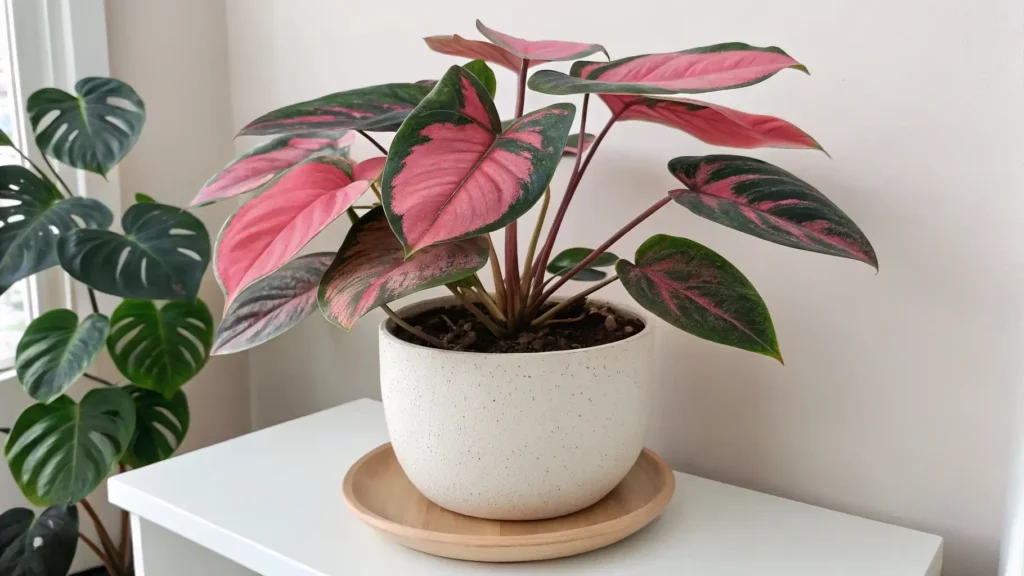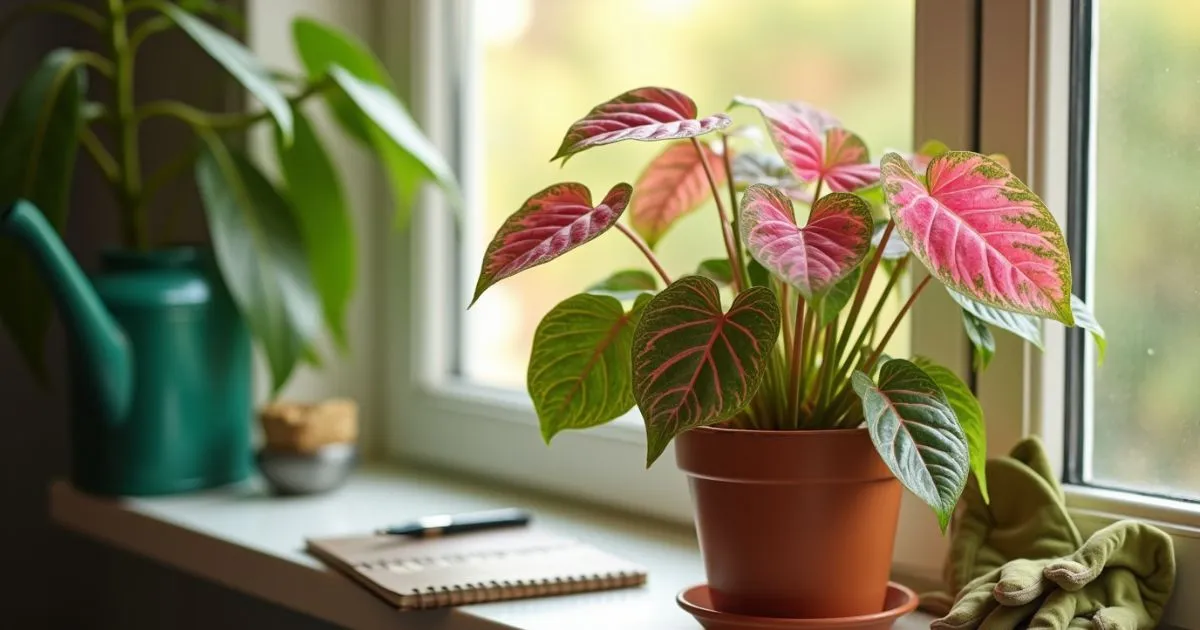In This Article
The Pink Philodendron, with its lush, variegated leaves and striking pink hues, is more than just a plant; it’s a statement piece for any indoor space. As you dive into the world of houseplants, you’ll find that the Pink Philodendron isn’t only about looks—its easy-care nature makes it a perfect addition for both plant newbies and seasoned gardeners alike. In this guide, you’ll find every detail you need to nurture and help your Pink Philodendron thrive. Whether you’re just starting out or aiming to refine your skills, here’s how you can create the ideal environment for this beauty.
What is the Pink Philodendron?
Quick Facts About Pink Philodendron
| Botanical Name | Philodendron erubescens |
| Family | Araceae |
| Plant Type | Tropical, Indoor Plant |
| Maximum Size | Up to 3 feet indoors |
| Light Requirements | Bright, indirect sunlight |
| Soil Requirements | Well-draining potting mix |
| Watering Needs | Moderate; allow soil to dry partially |
| Toxicity | Harmful to pets and humans if consumed |
The Pink Philodendron, scientifically known as Philodendron erubescens, is a captivating tropical plant that brings a splash of color to any indoor space. Originating from Central and South America, this plant’s rosy pink leaves and variegation make it highly desirable for plant enthusiasts. Not only is it easy to care for, but it also purifies the air, creating a healthier home environment.

Why Add a Pink Philodendron to Your Space?
Introducing a Pink Philodendron to your home goes beyond aesthetics. This plant stands out not only for its eye-catching color but also for its functional qualities. Here’s why it’s worth the addition:
- Visual Appeal: Its unique coloring adds style to any room.
- Air Purification: Known to filter toxins from the air, making it a great indoor air purifier.
- Easy Maintenance: This plant is beginner-friendly, adapting well to different indoor conditions.
Setting Up the Right Environment
Lighting is crucial for the Pink Philodendron. It thrives best in bright, indirect sunlight. Direct sunlight can be too intense, causing the leaves to burn or fade, so placing it near an east- or north-facing window is ideal. Bright but filtered light encourages vibrant coloring and prevents leggy growth.
Planting and Soil Tips
Choosing the Best Soil
Soil plays a huge role in the plant’s health. Pink Philodendrons require a well-draining soil mix to prevent waterlogging, which can lead to root rot. You can use a mix of potting soil, perlite, and orchid bark for an ideal blend that promotes both aeration and drainage.
Recommended Soil Mix:
- 1 part potting soil
- 1 part perlite
- 1 part orchid bark
Choosing the Right Pot
This plant is sensitive to water retention, so a terracotta pot works well for its breathability. However, any pot with drainage holes can be effective for a Pink Philodendron.
Watering Your Pink Philodendron
Watering is where many plant owners get tripped up. The Pink Philodendron needs moderate watering—typically once a week during warmer months and less in the cooler seasons. Water when the top inch of soil feels dry to the touch, and avoid overwatering, as this can lead to root issues.
Tips for Proper Watering
- Watering Frequency: Once a week, or when the soil’s top layer feels dry.
- Avoid Overwatering: Root rot is common when the plant is overwatered.
- Water with room-temperature water to avoid shocking the plant.
Fertilizing for Vibrant Growth
For lush, colorful growth, fertilize your Pink Philodendron monthly during the growing season, spring through summer. A balanced liquid fertilizer (20-20-20) diluted to half strength works well. Hold off on fertilizing during the inactive fall and winter seasons
Natural Fertilizer Alternatives :
If you prefer an organic approach, compost or worm castings are excellent options. These natural fertilizers provide slow-releasing nutrients that enrich the soil without chemicals.
Pruning and Propagating Your Pink Philodendron
Pruning and propagation are both simple and rewarding with the Pink Philodendron.
Pruning Tips
Prune your plant to remove yellow or damaged leaves, which can help the plant focus energy on healthy growth. It’s best to prune during spring or early summer.
Propagation
Propagation is done easily through stem cuttings, which is an ideal way to grow more plants or share them with friends.
Steps for Stem Cutting Propagation:
- Select a strong stem that has several leaves.
- Make a cut just below a node and place the stem in either water or soil.
- In a few weeks, roots should form. So, you can transfer it into a pot.
Common Issues and How to Solve Them
Even the easiest plants have their occasional problems. Below are some common issues with Pink Philodendrons and how to address them.
Yellowing Leaves
This could mean overwatering or poor light conditions. Make sure the soil dries out between waterings, and check for adequate light.
Leggy Growth
If the plant looks stretched or sparse, it may not be getting enough light. Moving it to a brighter spot can help it grow fuller.
Pests
Spider mites, aphids, and mealybugs are common pests for this plant. Wipe down the leaves with a damp cloth regularly, or use neem oil as a natural pest repellent.
Frequently Asked Questions
What light conditions are best for the Pink Philodendron?
Bright, indirect light is ideal. Keep the plant out of direct sunlight to prevent leaf damage.
How often should I water my Pink Philodendron?
Water when the top inch of soil is dry, typically once a week.
What type of soil should I use?
A well-draining mix of potting soil, perlite, and orchid bark works best.
How can I propagate a Pink Philodendron?
You can propagate through stem cuttings placed in water or soil.
Is the Pink Philodendron safe for pets?
No, it’s toxic to pets if ingested, so keep it out of reach.
Conclusion
The Pink Philodendron is a rewarding and beautiful addition to any indoor space. Its vibrant colors, easy-care routine, and versatility make it a beloved choice for plant enthusiasts. By understanding its specific needs—lighting, watering, soil, and occasional pruning—you can create an environment where your plant thrives.
Are you ready to start your journey with the Pink Philodendron? Share your experiences, tips, or pictures in the comments below or join our community online to connect with other plant lovers. Happy gardening!

